PREVIOUS
SDG Goal wise programs of India – Part 07
SDG Goal wise programs of India – Part 07
(இதன் தமிழ் வடிவத்திற்கு இங்கே சொடுக்கவும்)
Pradhan Mantri Fasal Bima Yojana (PMFBY)
Launched:
- Pradhan Mantri Fasal Bima Yojana (PMFBY) was launched in 2016 by the Government of India.
- This helps to provide crop insurance coverage and financial support to farmers in the event of crop loss or damage due to natural calamities, pests, and diseases.
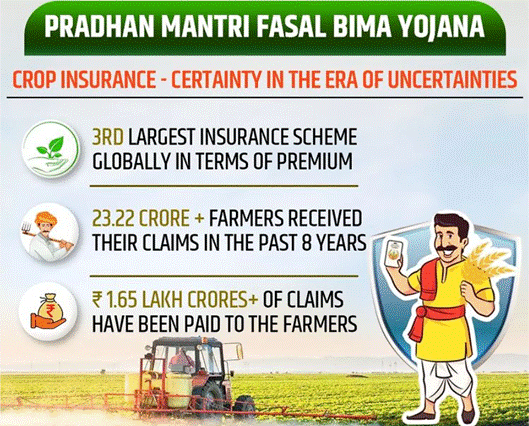
Ministry or Nodal Agency:
- The Ministry of Agriculture & Farmers Welfare.
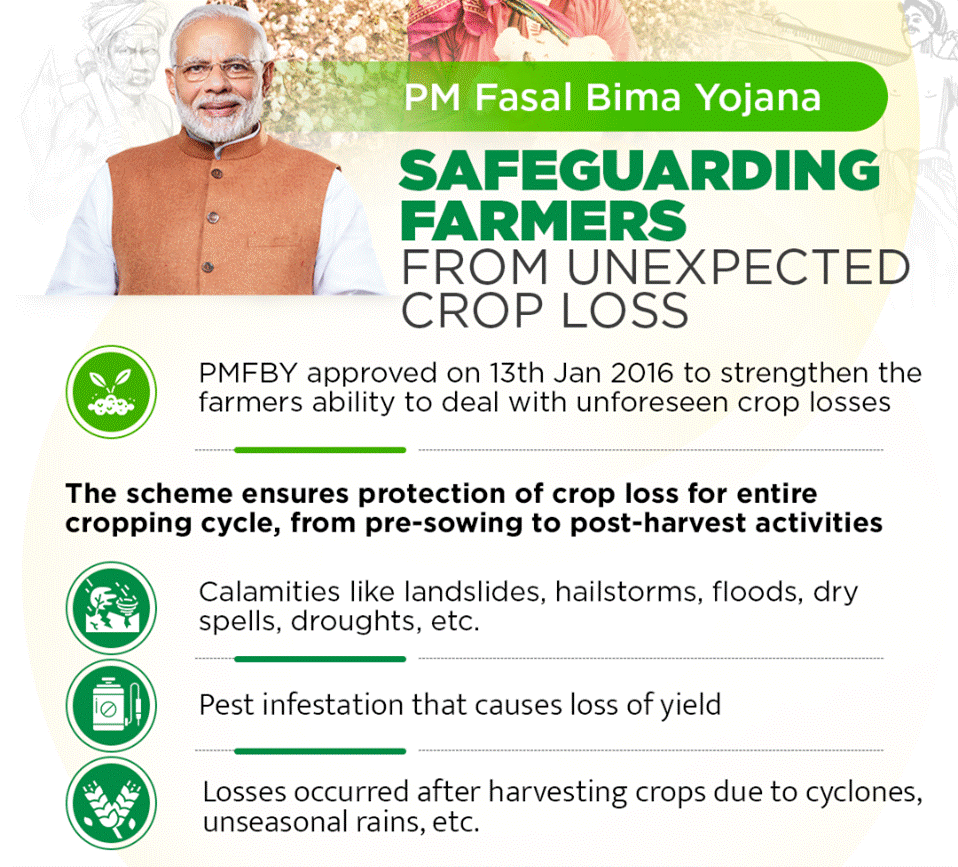
Objectives:
- Risk mitigation: Provide financial support to farmers who experience crop loss due to natural calamities such as floods, droughts, landslides, hailstorms, etc.
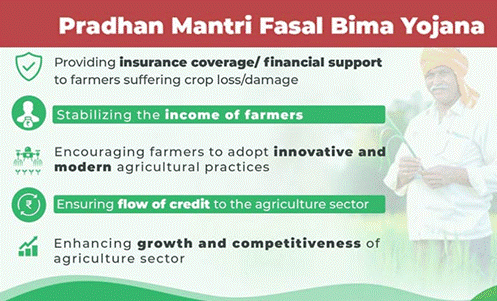
- Income stabilization: Stabilize the income of farmers and enable them to continue farming despite crop losses.
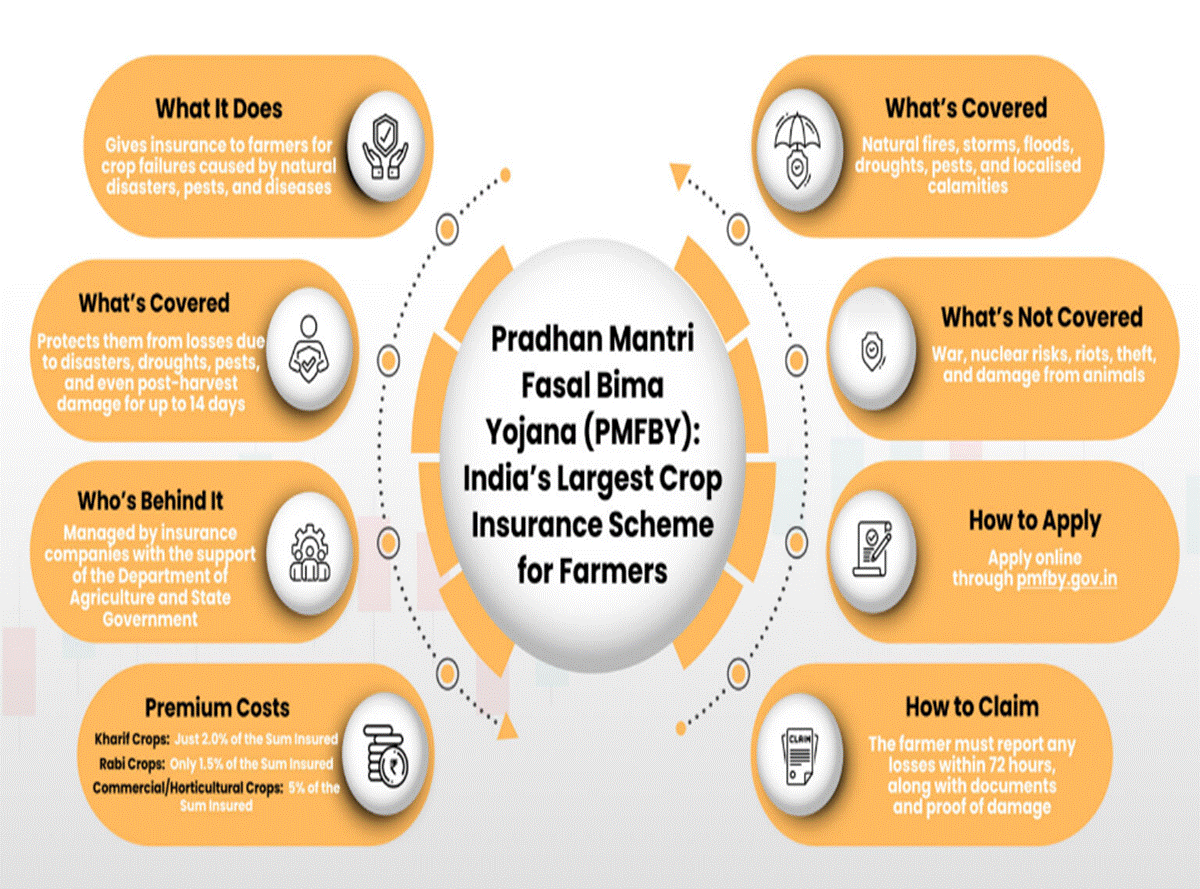
- Promotion of modern practices: Encourage farmers to adopt modern technology and practices to improve agricultural productivity and efficiency.
- Credit flow: Ensure the continuous flow of credit to the agricultural sector, thereby supporting food security, crop diversification, and enhancing the competitiveness of the agricultural sector.
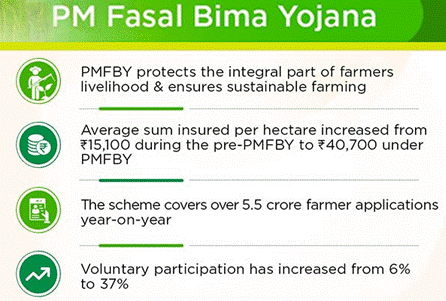
Beneficiaries:
- Farmers (both small and large) engaged in the cultivation of annual food crops, oilseeds, and horticultural crops.

- Farmers without institutional credit: Farmers not taking institutional credit can opt for voluntary participation.
Eligibility Criteria:
- Farmers cultivating food crops, oilseeds, and annual horticultural crops.
- Institutional loan borrowers: Farmers who have taken loans from banks for crop production are automatically enrolled.
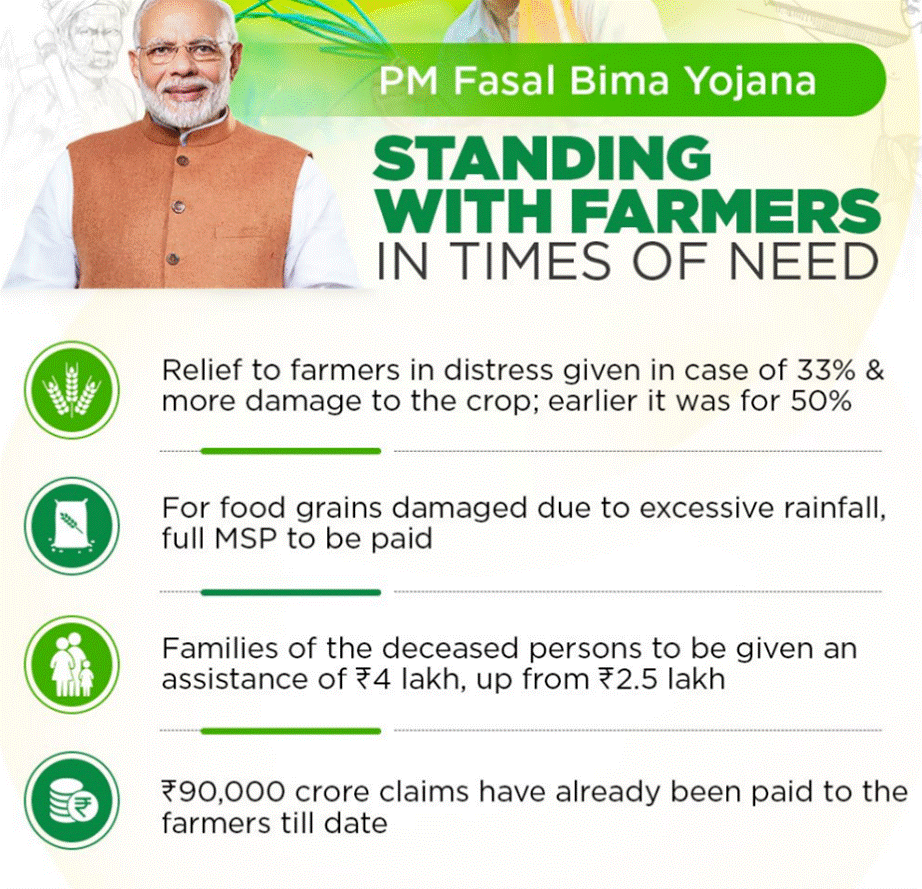
- Voluntary for non-loan borrowers: Farmers who do not avail loans can participate on a voluntary basis.
- Farmers from NE states: Special provisions are made for farmers in the northeastern states with increased premium subsidies.
Benefits:
- Comprehensive insurance coverage: Covers a wide range of calamities such as floods, droughts, pest attacks, and other localized risks.
- Post-harvest loss coverage: Provides insurance for losses that occur even after the harvest, including losses due to unseasonal rains and cyclones.
- Faster claim settlement: Use of technology such as drones, remote sensing, and smartphones for quicker and more accurate crop damage estimation.
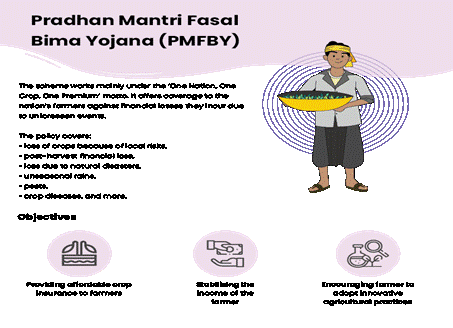
- Reduced premium burden: The government provides premium subsidies, with the premium cost shared between the government, the farmer, and the insurer.
- Direct benefit transfer (DBT): Claims are directly credited to farmers' bank accounts to ensure prompt payments.
Key Features:
- Area Approach: PMFBY uses an "Area Approach," where insurance coverage is provided for entire areas (panchayats or villages) rather than individual farms.
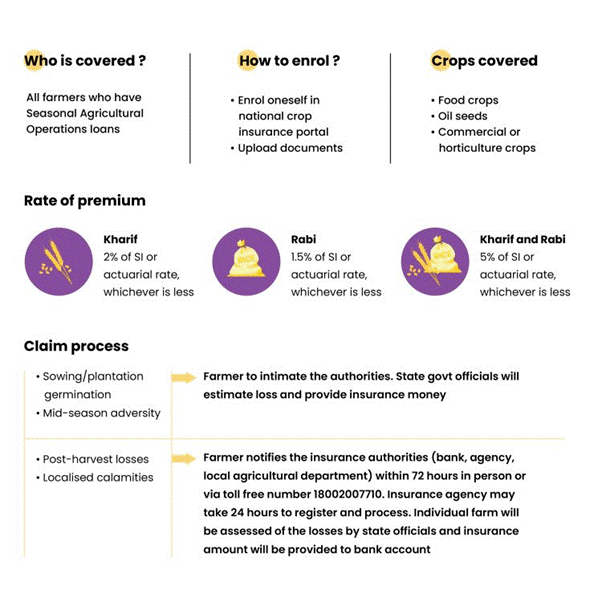
- Premium Subsidy: The government provides premium subsidies.
- For unirrigated areas, the central subsidy is up to 30%, and for irrigated areas, up to 25%.
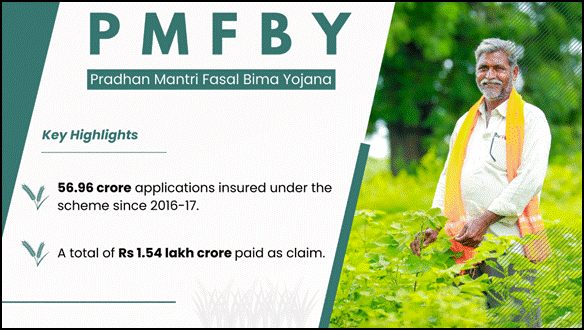
- Improved Post-Harvest Loss Coverage: Losses due to unseasonal rains, cyclonic rains, and pests are included in the scheme, which were previously not covered.
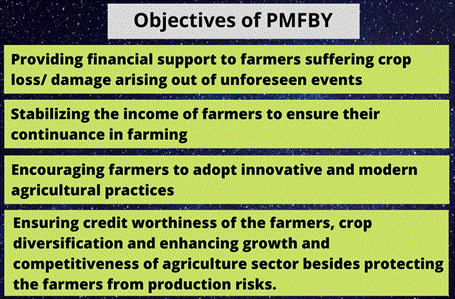
Revamping (PMFBY 2.0):
- The Union Cabinet approved the revamping of PMFBY to make it more effective.
Some of the key changes in PMFBY 2.0 include:
- Increased Subsidy for NE States: The share of the central government’s premium subsidy for northeastern states has been increased from 50% to 90%.
- Flexibility for States: States now have the option to choose their scale of finance for districts and select additional risk covers.
- Faster Claims Settlement: Technological interventions will enable quicker computation of yield estimates and faster settlement of claims.
- Penalty for Delays: States will be penalized if they fail to release the required premium subsidy to insurance companies within the set timelines.
Exclusions:
- The scheme does not cover the following:
- Losses due to war, terrorism, or hazardous activities.
- Losses caused by riots or malicious damage.
- Yield destruction caused by domestic or wild animals.
- Losses due to contamination from nuclear risks.
Additional Information:
- Implementation: PMFBY is implemented by a combination of state governments, insurance companies, and farmers.
- The scheme is aimed at boosting the agricultural sector and minimizing risks associated with farming.
- Smart Sampling Technique: The use of technology for crop cutting experiments (CCEs) to improve the accuracy of damage assessment.
- Information, Communication, and Education (ICE): Insurance companies are required to spend 0.5% of the total premium on ICE activities to raise awareness about the scheme.
National Mission for Sustainable Agriculture (NMSA)
Launched:
- 2014-15.
- The National Mission for Sustainable Agriculture (NMSA) is one of the eight missions under the National Action Plan on Climate Change (NAPCC).
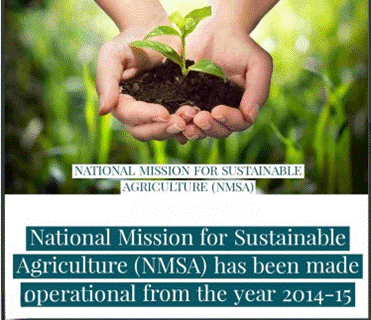
- The mission focuses on enhancing the agricultural sector's sustainability, improving productivity, and addressing the impacts of climate change on agriculture.
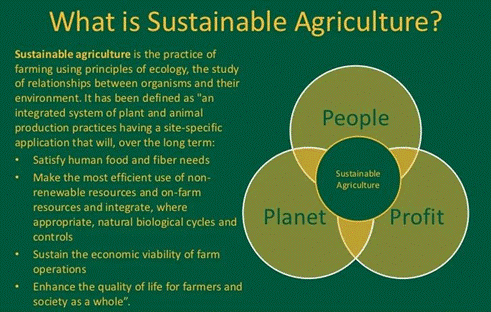
Ministry or Nodal Agency:
- The Ministry of Agriculture & Farmers Welfare is the nodal agency responsible for the implementation of NMSA, with support from other departments and ministries involved in environmental sustainability and rural development.
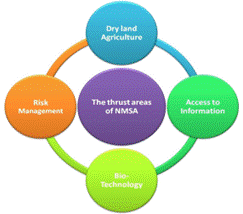
Objectives of NMSA:
- The primary objectives of the National Mission for Sustainable Agriculture (NMSA) are:
- Promote integrated farming systems that are location-specific to enhance productivity, sustainability, and resilience to climate change.
- Conserve natural resources, especially soil and water, to protect agricultural ecosystems.
- Improve soil health management through soil fertility mapping, judicious application of fertilizers, and precise nutrient management.
- Maximize water use efficiency by implementing the "more crop per drop" strategy to enhance water resource utilization.
- Enhance capacity building for farmers and stakeholders in climate change adaptation and mitigation strategies, aligning with other national initiatives like NICRA (National Initiative for Climate Resilient Agriculture).
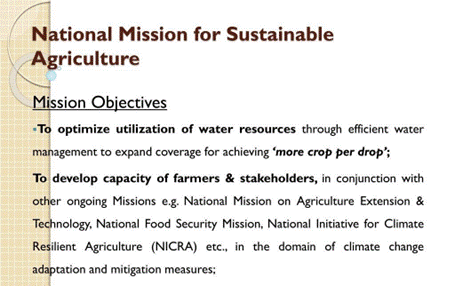
- Ensure effective inter-departmental coordination to meet the goals of rainfed agriculture and improve productivity in rainfed regions.
- Pilot innovative models in selected blocks to improve the productivity of rainfed farming by integrating technologies developed by NICRA and leveraging resources from other schemes like MGNREGS (Mahatma Gandhi National Rural Employment Guarantee Scheme).
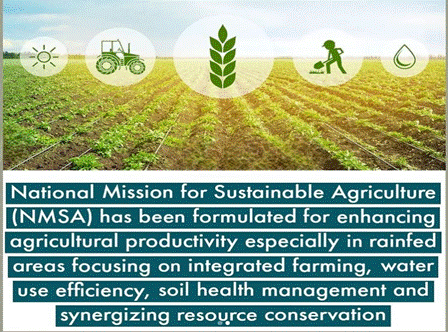
Components of NMSA:
- The NMSA is composed of four key components, each aimed at addressing different aspects of sustainable agricultural development:
Rainfed Area Development (RAD):
- Promotes conservation of natural resources and sustainable farming practices in rainfed areas.
- Uses a "watershed-plus" framework to optimize resource use from existing watershed development programs (like MGNREGS, RKVY).
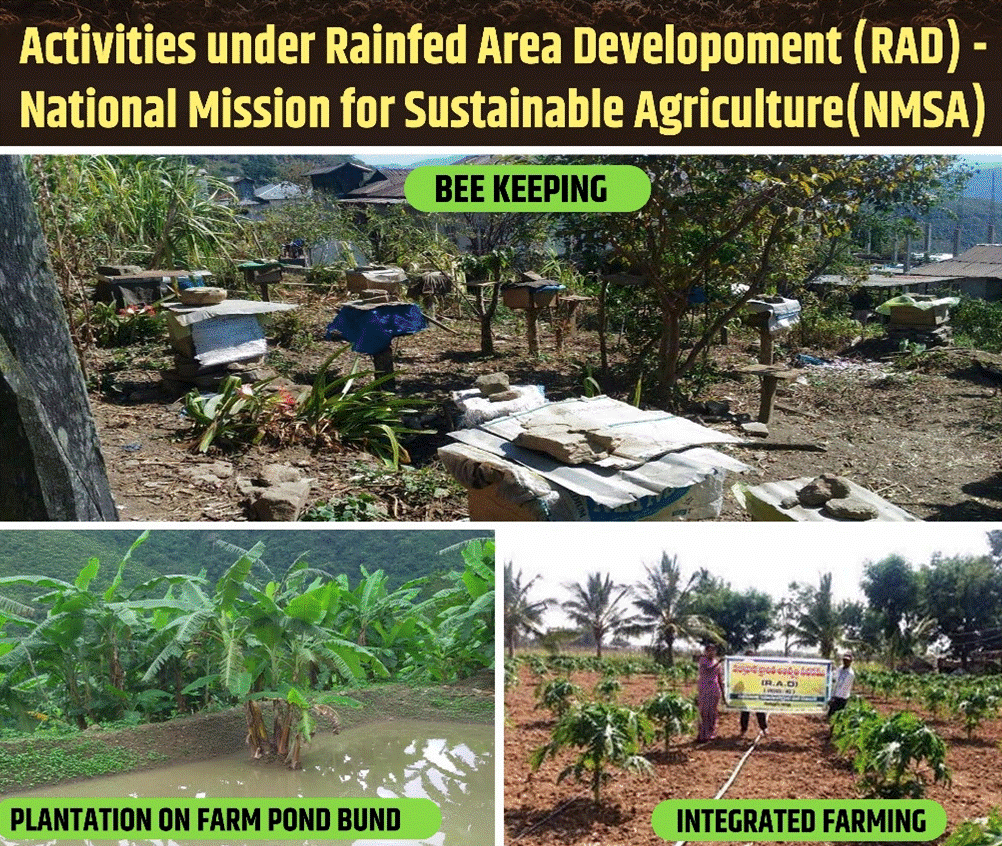
- Focuses on integrated approaches, combining agriculture, horticulture, livestock, fisheries, and agroforestry.
- Encourages the use of soil health cards and suitable crop selection based on agro-climatic conditions.
On-Farm Water Management (OFWM):
- Aims to improve water use efficiency on farms by adopting water-saving technologies such as rainwater harvesting and efficient irrigation systems.
- Focuses on enhancing the management of water resources through water users’ associations and participatory approaches.
- Encourages practices that maximize the efficiency of water application and distribution systems.
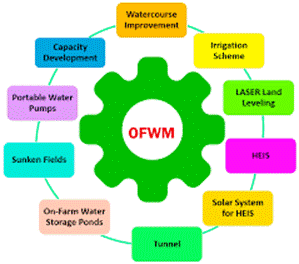
Soil Health Management (SHM):
- Promotes the development of soil fertility maps and the use of appropriate macro and micro-nutrients based on soil testing.
- Supports the adoption of sustainable land-use practices to prevent soil erosion and degradation.
- Aims to reclaim problematic soils, such as saline, alkaline, and acid soils, through targeted interventions by the National Center for Organic Farming (NCOF) and other relevant organizations.
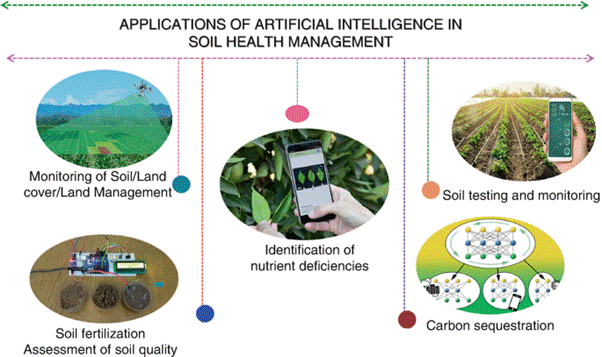
- Facilitates the integration of organic farming techniques and the development of best-practice packages tailored to local soil and land characteristics.
Capacity Building and Technology Transfer (CBTT):
- Focuses on building the capacity of farmers and stakeholders to adopt climate-resilient agricultural practices.
- Facilitates the transfer of knowledge and technologies through training programs, demonstrations, and workshops.
- Promotes the dissemination of climate-smart agricultural practices to improve productivity, sustainability, and resilience.
Regulations for Successful Implementation:
- To ensure the effective implementation of NMSA, the following regulations have been established:
- Guidelines on Harvesting and Transit: These guidelines help streamline the transit of agroforestry species and ensure their sustainable use.
- National Agroforestry Policy (2014): This policy promotes the integration of trees in agricultural lands and is aimed at increasing tree cover and enhancing soil fertility.
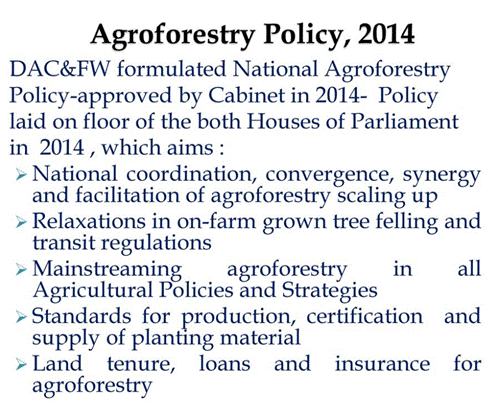
- Compensatory Afforestation Fund: The Compensatory Afforestation Fund Management and Planning Authority (CAMPA) oversees the financial allocations for the program, ensuring funds are used for sustainable agriculture and afforestation projects.
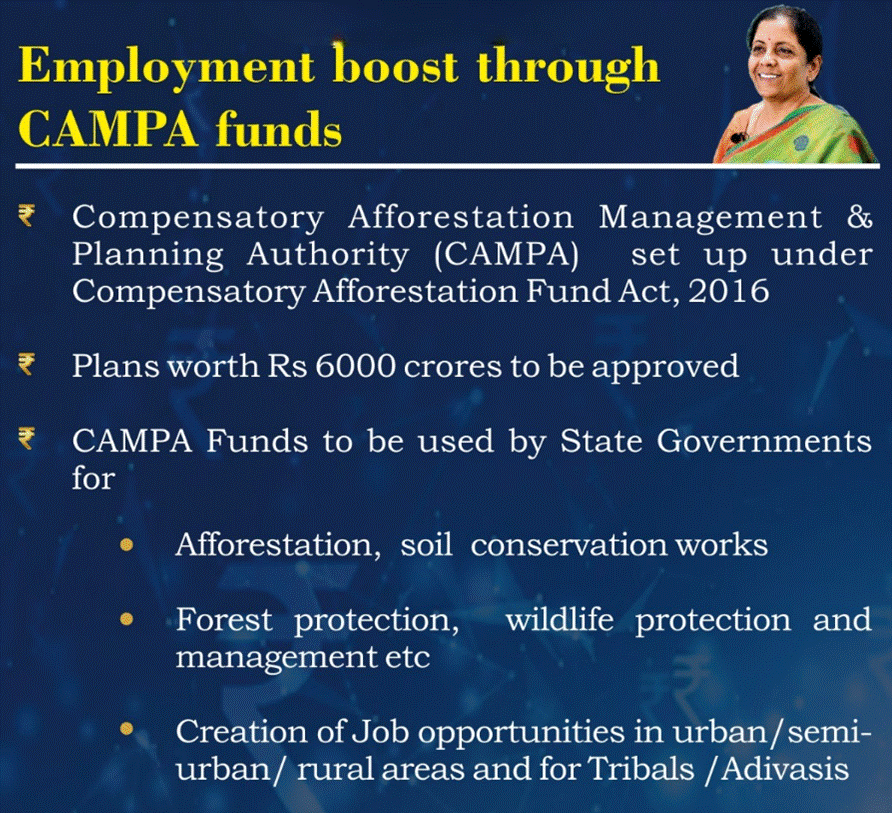
Sub-Mission on Agroforestry Scheme (SMAF):
- Under NMSA, the Sub-Mission on Agroforestry (SMAF) was launched in 2016-17 with the objective of increasing tree cover on agricultural lands to complement crop production.
- This initiative is based on the National Agroforestry Policy of 2014.
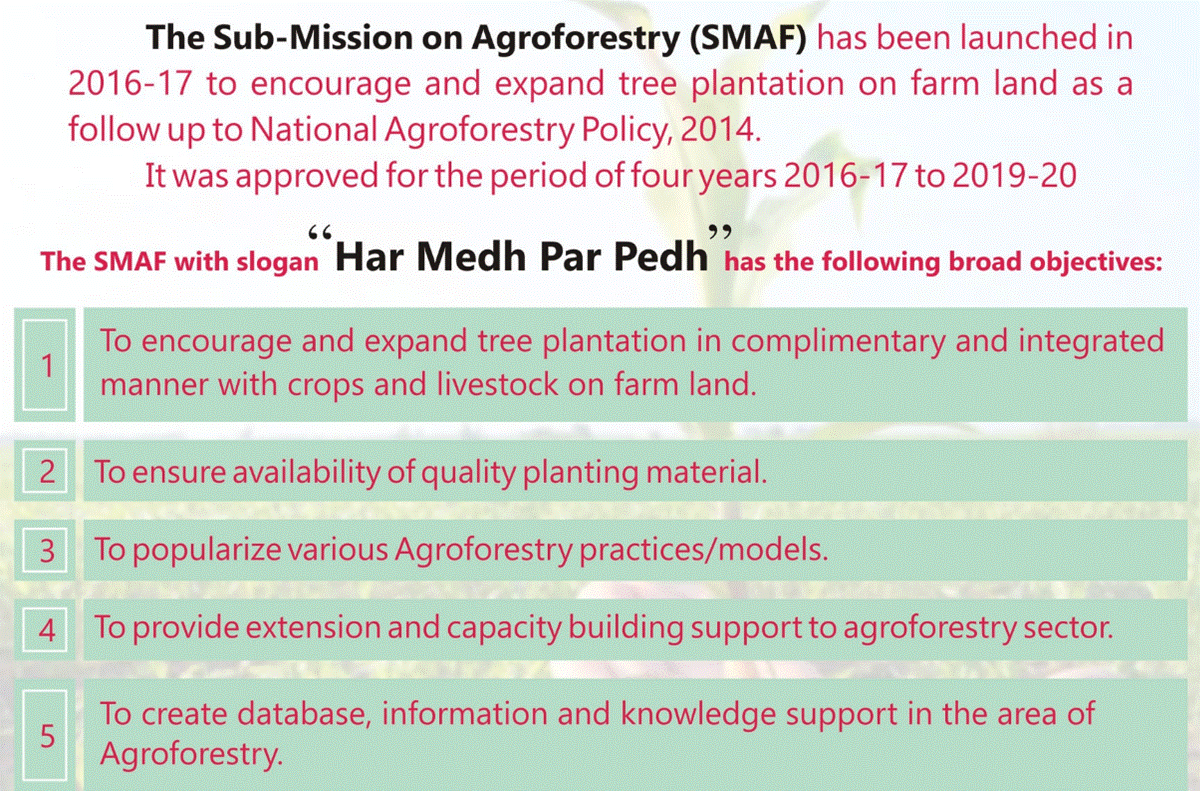
Objectives of SMAF:
- Improve soil fertility through increased organic matter content.
- Provide high-quality planting material for agroforestry.
- Increase the productivity of crops and cropping systems by integrating trees.
- Promote sustainable livelihoods for farmers through agroforestry.
- Establish an effective information system to support agroforestry initiatives.
Key Components of SMAF:
- Promotion of tree plantations on farm lands.
- Capacity building for farmers to adopt agroforestry practices.
- Use of agroforestry models that integrate both forestry and agricultural production for long-term sustainability.
Eligibility Criteria for NMSA:
- Farmers practicing agriculture in rainfed areas or those in need of improving soil health, water management, and climate resilience.
- Agroforestry initiatives are open to farmers interested in integrating trees with crop cultivation, with a focus on improving productivity and environmental sustainability.
Benefits of NMSA:
- Enhanced productivity of rainfed areas through improved water and soil management.
- Increased resilience to climate change through climate-smart agricultural practices.
- Improved soil health leading to better agricultural outputs and long-term sustainability.
- Sustainable water use through efficient irrigation systems and water conservation practices.
Additional Information:
- Interlinking with other schemes: NMSA works in synergy with other national initiatives like NICRA (National Initiative for Climate Resilient Agriculture) and MGNREGS (Mahatma Gandhi National Rural Employment Guarantee Scheme).
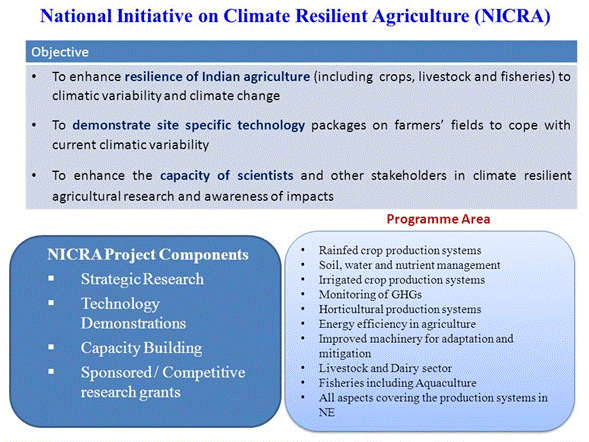
- Technological support: The mission incorporates GIS and remote sensing technologies to map soil health, assess water resources, and monitor the success of implemented programs.
- Integration with rural development: NMSA leverages resources from rural development programs like Integrated Watershed Management Programme (IWMP) and RKVY (Rashtriya Krishi Vikas Yojana).
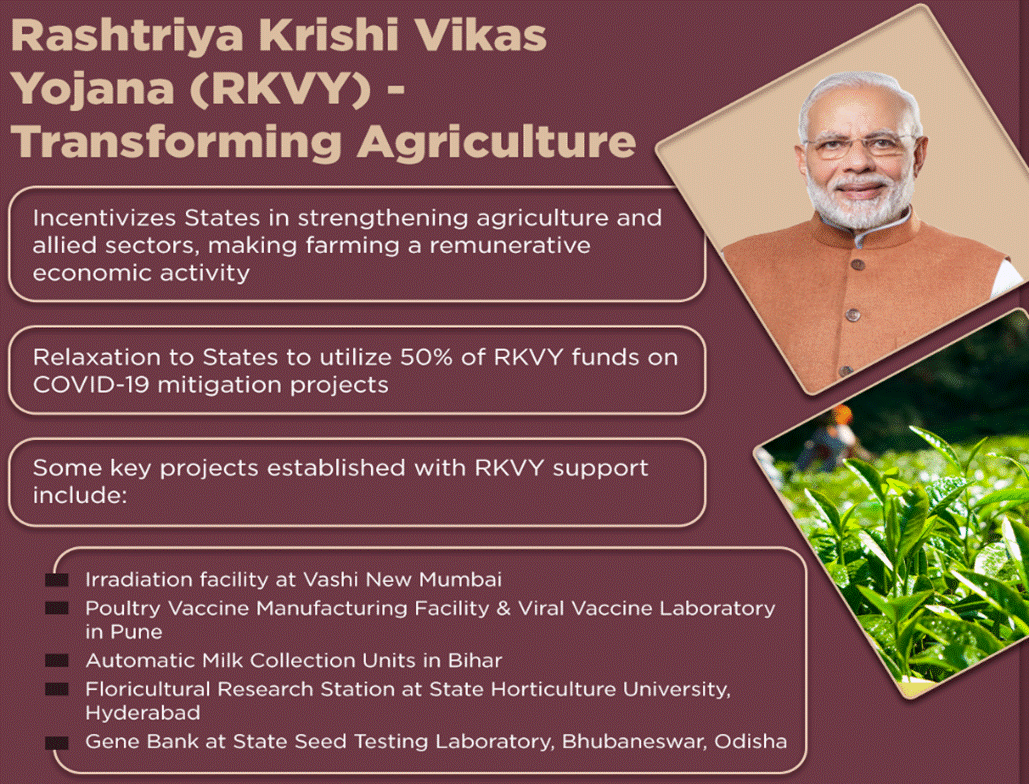
-------------------------------------


